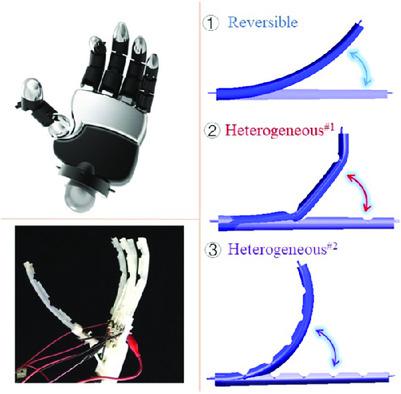当前位置:
X-MOL 学术
›
Adv. Eng. Mater.
›
论文详情
Our official English website, www.x-mol.net, welcomes your
feedback! (Note: you will need to create a separate account there.)
Intergrated Shape Memory Alloys Soft Actuators with Periodic and Inhomogeneous Deformations by Modulating Elastic Tendon Structures
Advanced Engineering Materials ( IF 3.4 ) Pub Date : 2020-08-27 , DOI: 10.1002/adem.202000640 Dachao Li 1 , Dong Niu 1 , Guoyong Ye 1 , Biao Lei 1 , Weitao Jiang 1 , Feng Luo 2 , Jinju Chen 3 , Xin Li 4 , Shaoxing Qu 5 , Hongzhong Liu 1, 6
Advanced Engineering Materials ( IF 3.4 ) Pub Date : 2020-08-27 , DOI: 10.1002/adem.202000640 Dachao Li 1 , Dong Niu 1 , Guoyong Ye 1 , Biao Lei 1 , Weitao Jiang 1 , Feng Luo 2 , Jinju Chen 3 , Xin Li 4 , Shaoxing Qu 5 , Hongzhong Liu 1, 6
Affiliation

|
The soft actuators similar to the periodic motion of biological organisms are accomplished based on assembling multiple unidirectional memory effect shape memory alloys (SMAs) components or introducing biasing elements, which give rise to the complex structure and difficult control of soft actuators. Herein, inspired by the power‐amplified biological systems, beneficial with the advantages of 3D integrated molding technology, an integrated SMA‐polydimethylsiloxane (PDMS) composite structure (SPCS) is proposed, which can achieve periodic heterogeneous actuation only by controlling the SMA phase transformation and the PDMS strain potential energy distribution states. To test the feasibility of the mechanism, a theoretical model of SPCS deformation is conducted. The results of numerical feasibility analysis show that the factors affecting SPCS deformation mainly involve the excitation current strength of SMA, PDMS structure thickness and its distribution state. The experimental results show that the current intensity mainly affects the deformation rate of SPCS, and the thickness of PDMS is not only the key to realize the periodic deformation of SPCS but also the orderly arrangement of PDMS structure thickness is helpful for SPCS to achieve periodic heterogeneous deformation. These demonstrate that the proposed mechanism can inspire the design of soft actuators, smart wearable equipment, and medical devices.
中文翻译:

集成的形状记忆合金软致动器,具有周期性和不均匀变形,可通过调节弹性肌腱结构实现
通过组装多个单向记忆效应形状记忆合金(SMAs)组件或引入偏置元件来实现类似于生物体的周期性运动的软致动器,这导致了软致动器的复杂结构和难以控制。在此,受功率放大生物系统的启发,受益于3D集成成型技术的优势,提出了集成的SMA-聚二甲基硅氧烷(PDMS)复合结构(SPCS),仅通过控制SMA相变即可实现周期性的异质驱动PDMS应变势能分布状态。为了验证该机制的可行性,建立了SPCS变形的理论模型。数值可行性分析结果表明,影响SPCS变形的因素主要涉及SMA的激发电流强度,PDMS结构厚度及其分布状态。实验结果表明,电流强度主要影响SPCS的变形速率,PDMS的厚度不仅是实现SPCS周期性变形的关键,而且PDMS结构厚度的有序排列有助于SPCS实现周期性的异质性。形变。这些表明,提出的机制可以启发软致动器,智能可穿戴设备和医疗设备的设计。实验结果表明,电流强度主要影响SPCS的变形速率,PDMS的厚度不仅是实现SPCS周期性变形的关键,而且PDMS结构厚度的有序排列有助于SPCS实现周期性的异质性。形变。这些表明,提出的机制可以启发软致动器,智能可穿戴设备和医疗设备的设计。实验结果表明,电流强度主要影响SPCS的变形速率,PDMS的厚度不仅是实现SPCS周期性变形的关键,而且PDMS结构厚度的有序排列有助于SPCS实现周期性的异质性。形变。这些表明,提出的机制可以启发软致动器,智能可穿戴设备和医疗设备的设计。
更新日期:2020-08-27
中文翻译:

集成的形状记忆合金软致动器,具有周期性和不均匀变形,可通过调节弹性肌腱结构实现
通过组装多个单向记忆效应形状记忆合金(SMAs)组件或引入偏置元件来实现类似于生物体的周期性运动的软致动器,这导致了软致动器的复杂结构和难以控制。在此,受功率放大生物系统的启发,受益于3D集成成型技术的优势,提出了集成的SMA-聚二甲基硅氧烷(PDMS)复合结构(SPCS),仅通过控制SMA相变即可实现周期性的异质驱动PDMS应变势能分布状态。为了验证该机制的可行性,建立了SPCS变形的理论模型。数值可行性分析结果表明,影响SPCS变形的因素主要涉及SMA的激发电流强度,PDMS结构厚度及其分布状态。实验结果表明,电流强度主要影响SPCS的变形速率,PDMS的厚度不仅是实现SPCS周期性变形的关键,而且PDMS结构厚度的有序排列有助于SPCS实现周期性的异质性。形变。这些表明,提出的机制可以启发软致动器,智能可穿戴设备和医疗设备的设计。实验结果表明,电流强度主要影响SPCS的变形速率,PDMS的厚度不仅是实现SPCS周期性变形的关键,而且PDMS结构厚度的有序排列有助于SPCS实现周期性的异质性。形变。这些表明,提出的机制可以启发软致动器,智能可穿戴设备和医疗设备的设计。实验结果表明,电流强度主要影响SPCS的变形速率,PDMS的厚度不仅是实现SPCS周期性变形的关键,而且PDMS结构厚度的有序排列有助于SPCS实现周期性的异质性。形变。这些表明,提出的机制可以启发软致动器,智能可穿戴设备和医疗设备的设计。











































 京公网安备 11010802027423号
京公网安备 11010802027423号